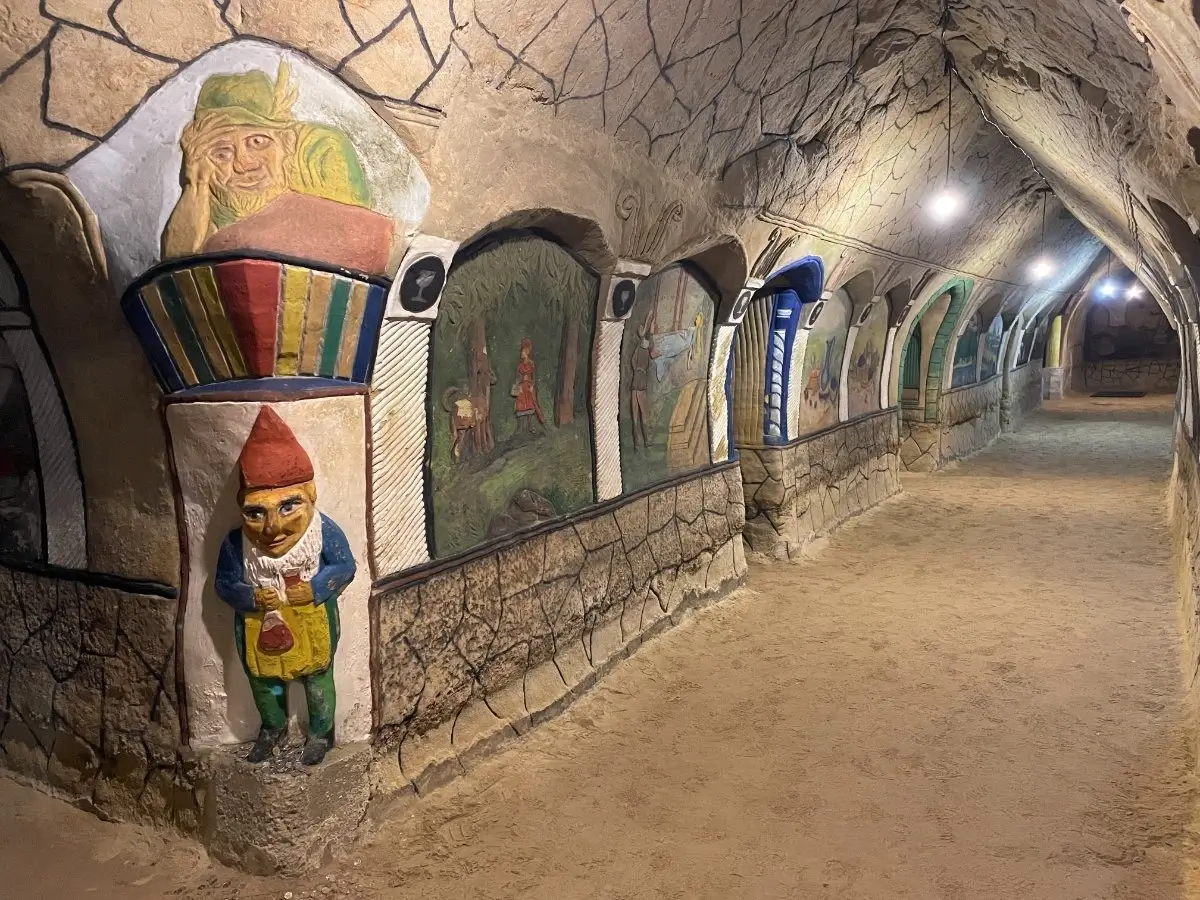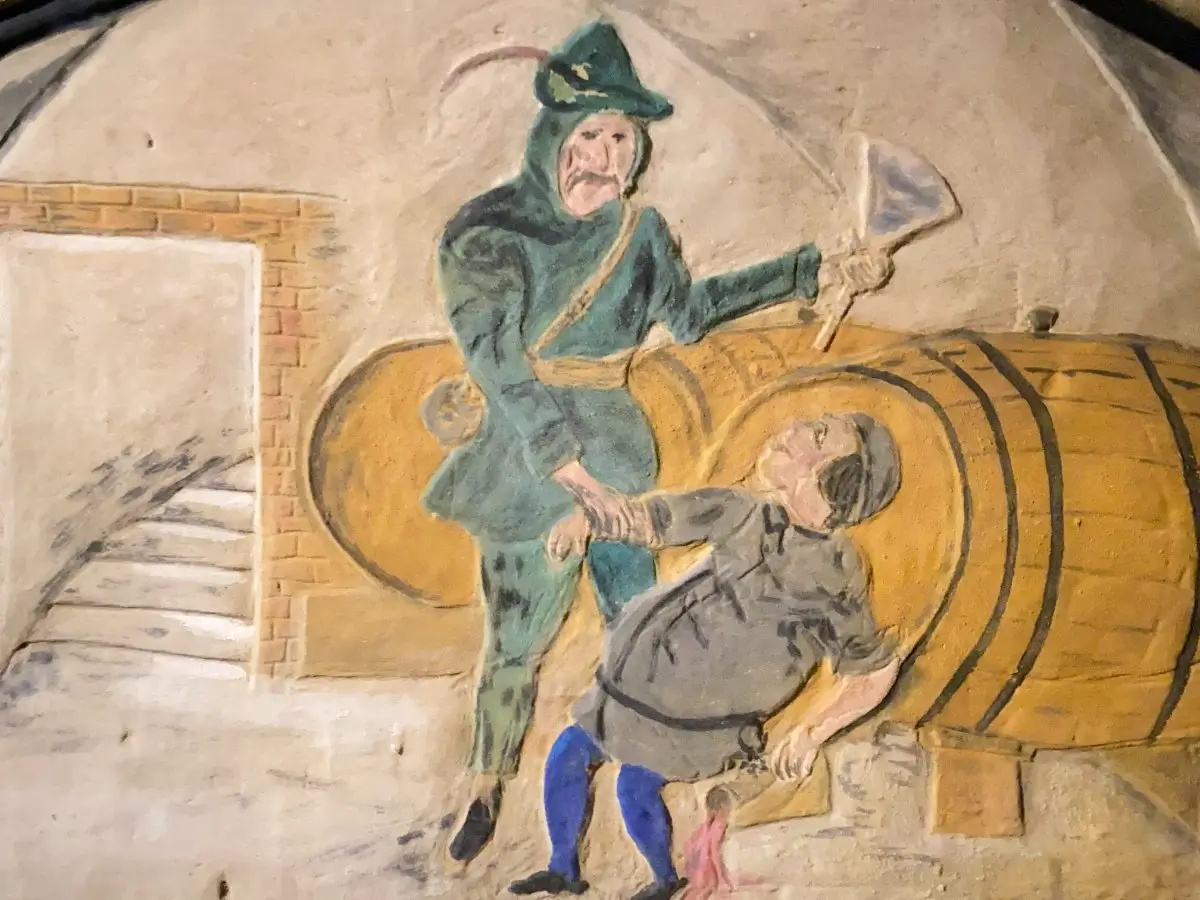The cellar is 300 years old, though it wasn’t originally used for wine-making, as it was a sand mine. Its sand was of such high quality that it was transported to Vienna, where it was added to stucco mortars. The Vienna Town Hall, for example, was repaired with sand from Šatov.
For around 200 years, the cellar’s history is unclear, though it was likely used to store fruits and vegetables, until 1884 when Mr Tunkl, its first owner, opened the first private wine bar. Boxes were carved during this period, and the wine bar operated until 1945.

Why the Painted Cellar?
In 1934, a local from Šatov, Maximilian Apeltauer, offered the then owners, the Thayer family, to decorate their wine bar. He liked it so much that he continued to do so for the next 34 years. For the first 6 years he worked with both hands, but then he had to join the Wehrmacht, where he lost his left hand in the first months of the Second World War. Left with just a stump, he would attach a board to it, place his paints and candles on it, and paint with just one hand. Working in darkness, he could only see the section he was painting at any given moment. Apeltauer worked entirely in his free time and for no payment. The cellar is made of Tertiary period marine sand deposits, which are easy to carve but don’t hold paint well. Apeltauer developed a technique where he would first carve a relief into the walls, then apply water glass, let it dry, and finally add the paint, using earth pigments.
The first room in the cellar is the Ladies’ Lounge, followed by the Tyrolean Hunting Lounge, the Gentlemen’s Lounge, and finally the Dancing Lounge, which was only used for listening to music rather than dancing because of the small space. On the opposite wall, there’s a self-portrait of Apeltauer, alongside dates marking when he began and finished his work. Surrounding these are paintings of the 1920s depicting landmarks like the Vienna Town Hall, Vranov Castle, the Prater Ferris Wheel and views of Znojmo. The deepest part of the cellar is at the end of the corridor, reaching 18 metres below ground.
The cellar also has an old shaft, which was originally used by gentlemen visiting the wine bar, sometimes accompanied by ladies of ill repute. One man would stand guard above the shaft, and if their wives were approaching, the women would be hidden in the shaft. In later years, the shaft was used by smugglers to hide goods from customs officers.
In the 1950s, the local cooperative farm reopened the wine bar in the cellar. However, as the walls featured German-themed images that were no longer politically acceptable, Apeltauer was asked to modify them. For example, the cooperative farm emblem was originally the emblem of the Sudeten German Party. The 1938 bunker as it was left by the Czechoslovak soldiers when they were removed from the border area now looks different too.
The two-year plan emblem was also modified in the 1950s, because originally there was a swastika. The Blue Greeting from Radhošť displayed the German eagle until 1965, and you can still see the original elements. The Young Builders mural was also reworked, as it once portrayed Adolf Hitler with his arm raised in salute. This was painted when the Thajers owned the bar as they were staunch supporters of Hitler. When Hitler visited their cellar in 1938, they had Apeltauer paint his portrait. “Czechoslovakia must disappear from the map, and soon it will!” Hitler said in 1938 in Šatov. At the end of the corridor, there are murals depicting fairytales – these are the oldest and have never been altered.
Old-timers remember Apeltauer working in the cellar with a hat with candles, possibly for better lighting, or maybe he wanted to resemble Spanish painters because for example Goya wore it like that.

It wasn’t until shortly before his death that Apeltauer told his closest friends the reason he began painting the cellar: a woman named Rosa Thajer, the daughter of the original owners. He spent hours in the cellar to see and be near her, although he never confessed his love. After the war, Rosa and her family were expelled from the border region, and Apeltauer married a Czech woman. He remained in Šatov until his death in 1972. However, he never forgot Rosa, and left her portrait in the back of the Pink Lounge. Beneath it is the only preserved German inscription in the cellar.
There is also a 30-metre-deep mine shaft in the cellar with two levels of tunnels. Besides the sand that was mined, Šatov was also home to a ceramics factory and brickworks, which used clay from the tunnels. Some winemakers boast several kilometres of underground corridors due to this mining.
There were barrels of wine all around, but it was always imported here, never produced, because the year-round temperature of this cellar is only 8 degrees, and that is not enough to make wine.The murals require upkeep due to natural humidity and frequent tours. A woman who worked in the cooperative farm in the 1950s and knew Apeltauer still restores the murals when needed, as she knows the original technique.
